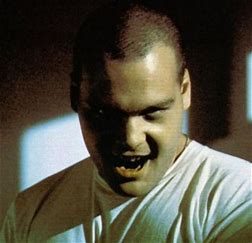Article-Detail

Leonard Lawrence and the Consequences of Melancholia
In 1987, the Movie Full Metal Jacket was released in theaters around the world. I enjoyed about the first 40 minutes of the movie and usually got bored with Vietnam. The first half depicted basic training for marines who were to be sent to the war. Movie viewers were delighted by the brutal Gunnery Sargent Hartman played by Lee Ermey as he unloaded on the overweight and dim witted Private Leonard Lawrence played by Vincent D’Onofrio. The scene was set at Marine Corps Recruit Depot Parris Island, within Port Royal, South Carolina with a full platoon; however, the focus was on the abusive relationship between Hartman and Lawrence. From the start, Hartman nicknames Lawrence “Gomer Pyle”, after the simple-minded mechanic turned marine character from the Gomer Pyle television show from the 1960s.
Because of his weight and mental limitations, Hartman insulted, derided, badgered, excoriated, castigated, and name called Lawrence daily, taking an emotional toll that no one took the time to calculate. Lawrence slowly improves with the help of Joker, a character played by Matthew Modine, who was paired to mentor Lawrence. After Lawrence is caught with a jelly donut, Hartman begins to punish the platoon for Lawrence’s shortcomings. The platoon begins to resent Lawrence and holds a “blanket party” in his honor. In this party, the members of his platoon wraps a bar of soap in a towel and beats him with it. After the blanket party, Lawrence's performance improves dramatically but signs of his mental breakdown begin to show. Joker notices Lawrence talking to his gun.
The last night of boot camp, after each of the soldiers got their orders for the next day, Lawrence is found in the restroom loading his rifle and doing drills. When he isn’t reciting chants he speaks slowly and breathes audibly. He holds his head down and looks at Joker just under his lashes and eyebrows with a menacing smile. Hartman’s sleep is disturbed by Lawrence’s chanting and he addresses the situation in the latrine. Hartman is shot while trying to get Lawrence to give him the gun, then Lawrence shoots himself. Private Lawrence, had a mental breakdown caused by stress. Hartman, the source of the frustration, paid the price.
Panic attacks, crying, depression, and short temper are symptoms of what psychologists call melancholia. These symptoms lead to a condition called anhedonia which is described by unimaginable sadness, slowed thought and movement, feeling as if the sins of their past are unforgivable, there is no pleasure in the present, and the future offers no hope. This is why people who suffer for extended periods often commit suicide. Particularly hostile victims often seek to exact harm on their tormentor before killing themselves. Psychologists estimate that only a quarter of patients with depression also have melancholia. The rest have a lot going on in their lives that is causing a debilitating sadness. Melancholia is caused by existing in an extended period of “fight or flight”. The body is designed for short periods of this state, long periods can cause mental, physical and emotional breakdown.
Not all people who experience stress from work demonstrate signs of melancholia or suicidal thoughts. Most people suffer quiet symptoms that are more difficult to link directly to work related stress but research is now making that link. The Center for Disease Control (CDC) reports “Stress sets off an alarm in the brain, which responds by preparing the body for defensive action. The nervous system is aroused and hormones are released to sharpen the senses, quicken the pulse, deepen respiration, and tense the muscles. This response, fight or flight, is important because it helps us defend against threatening situations. The response is preprogrammed biologically. Everybody responds the same way.” Their report continues, “Short-lived or infrequent episodes of stress pose little risk. But when stressful situations go unresolved, the body is kept in a constant state of activation, which increases the rate of wear and tear to biological systems. Ultimately, fatigue or damage results, and the ability of the body to repair and defend itself can become seriously compromised. As a result, the risk of injury or disease escalates.” The brain doesn’t make the distinction between being chased by a dog, a close call in traffic, an abusive boss, the same response occurs.
For these reasons, causing people to suffer can result in bickering, illness, unproductive behaviors and harm. An abusive boss is bad for business, no matter the industry. I have heard bosses say, “I do it to motivate my team”. In a 2000 report commissioned by the Postmaster General in response to postal shootings, the commission chair justified the treatment of mail carriers, describing it as a motivational tool. By 1996, when the research was commissioned, postal shootings had reached its height. In 2000, the behavior was minimized. People need their jobs to provide for themselves and their families and can’t just leave. Bully bosses know that and take advantage of their positional power and their employees need for their job. Research suggests that 60% of employees have been a target, a witness or have heard stories of abuse at work. Without making distinctions, their brains go into fight or flight, building to some level of melancholia.
A supportive boss can have the opposite, positive impact on others. Checking in on people, offering encouragement, and giving people space to try new things and make mistakes is good for everyone. People bring their experiences home with them and their families either tries to put together the pieces or enjoys an energizing parent. The people in your charge are parents, spouses, friends, and have lives that extend far beyond work. A person made miserable at work isn’t whole to experience the bigger, more meaningful parts of their lives. If you’re a boss, consider your words and actions carefully. If you hire bosses, deal with someone who makes people miserable, it isn’t good for your organization, your employees, or the people they serve. A great boss can energize people and give customers an experience that will bring them back. Leonard Lawrence is a fictional character but his experience and response to it is real. Keep that in mind and SOAR!
William A. Brown
October 13, 2019
https://www.healthyplace.com/blogs/borderline/2012/11/the-invisible-enemy-bpd-and-the-military
https://www.npr.org/templates/story/story.php?storyId=112717611
https://www.cdc.gov/niosh/docs/99-101/default.html#Job%20Stress%20and%20Health




